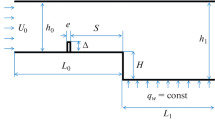Abstract
A numerical study based on the large eddy simulation methodology was made of heat transfer in locally disturbed turbulent separated and reattached flow over a backward facing step. The local disturbance was given to the flow by a sinusoidally blowing/suction of the fluid into a separated shear layer. The Reynolds number was fixed at 33,000 and Richardson number at 0.5. The disturbance frequency was varied in the range 0 ≤ St ≤ 2, where St is the Strouhal number of disturbance. The obtained results revealed the existence of an optimum perturbation frequency value, St = 0.25, in terms of the reduced reattachment length. At this frequency the heat transfer is significantly enhanced in the recirculation zone. The influence of the frequency and the amplitude of disturbance, in the maximum heat transfer positions and the maximum local Nusselt number, is analysed.








Similar content being viewed by others
Abbreviations
- A :
-
Amplitude of disturbance
- f :
-
Frequency of disturbance
- g :
-
Gravitational acceleration
- H :
-
Computational domain width
- h :
-
Step height
- Nu :
-
Local Nusselt number H(−∂θ/∂y)w
- Nu max :
-
Maximum local Nusselt number
- Re :
-
Reynolds number (U o H/ν)
- Ra :
-
Rayleigh number (gβ(T h − T c)H 3/νκ)
- Ri :
-
Richardson number (Ra/Re 2·Pr)
- P :
-
Pressure
- Pr :
-
Prandtl number
- St :
-
Strouhal number (fh/U o)
- u i :
-
Velocity vector
- u :
-
Longitudinal velocity
- U o :
-
Maximum velocity in the inlet
- v :
-
Transverse velocity
- t :
-
Time
- T :
-
Temperature
- x, y:
-
Cartesian coordinates
- X r :
-
Reattachment length
- X max :
-
Maximum heat transfer abscissa
- β:
-
Thermal expansion coefficient
- κ:
-
Thermal diffusivity
- ν:
-
Kinematic viscosity
- νt :
-
Turbulent viscosity
- θ:
-
Dimensionless temperature (T − T C/T h − T C)
- σ c :
-
Turbulent Prandtl number
- C:
-
Cold
- h:
-
Hot
- w:
-
Wall
- o:
-
Non-disturbed case
References
Chun KB, Sung HJ (1996) Control of Turbulent separated flow over a backward-facing step. Exp Fluids 21:417–426
Chun KB, Sung HJ (1998) Visualization of a locally-forced separated flow over a backward-facing Step. Exp Fluids 25:133–142
Shishov EV, Roganov PS, Grabarnik SI, Zabolotsky VP (1988) Heat transfer in the recirculating region formed by a backward-facing step. Int J Heat Mass Transfer 318:1557–1562
Aung W, Watkins CB (1978) Heat transfer mechanisms in separated forced convection. In: Proceedings of the NATO Institute on turbulent forced convection in channels and bundles: theory and applications to heat ex-changers, Turkey, June 20–Aug 2, 1978
Vogel JC, Eaton JK (1985) Combined heat transfer and fluid dynamic measurements downstream of a backward-facing step. J Heat Transf 107:922–929
Sparrow EM, Kang SS, Chuck W (1987) Relation between the point of flow reattachment and maximum heat transfer for regions of flow separation. Int J Heat Mass Transf 307:1237–1276
Rhee GH, Sung HJ (2000) Enhancement of heat transfer in turbulent separated and reattaching flow by local forcing. Numer Heat Transf Part A 37:733–753
Yoshioka S, Obi S, Masuda S (1999) Momentum transfer in the periodically perturbed turbulent flow over a backward-facing step. In: Banerjee S, Eaton JK (eds) Turbulence and shear flow phenomena-1. Begell House, Inc, pp 1321–1326
Ta Phuoc L (1994) Modèles de sous maille appliqués aux écoulements instationnaires décolles, DGA/DRET. Journée thématique DRET. Aérodynamique instationnaire turbulent, aspects numériques et expérimentaux, France
Sagaut P (1998) Introduction à la simulation des grandes échelles pour les écoulements de fluide incompressible. In: Collection Mathématiques et applications, vol 30. Springer, 282 pp
Leonard BP (1988) Simple high accuracy resolution program for convection modeling of discontinuities. Int J Numer Methods Fluids 8:1291–1318
Chorin A (1968) Numerical simulation of the Navier–Stokes equations. J Math Comput 22:745–762
Temam R (1968) Une méthode d’approximation de la solution des équations de Navier–Stokes. Bull Soc Math France 98:115–152
Rhee GH, Sung HJ (2000) Turbulent numerical prediction of locally forced separated and reattaching flow. Fluid Dynam Res 26:421–436
Abbassi H, Ben Nassrallah S (2007) MHD flow and heat transfer in a backward-facing step. Int Commun Heat Mass Transf 34:231–237
Velazquez A, Arias JR, Mendez B (2008) Laminar heat transfer enhancement downstream of a backward facing step by using a pulsating flow. Int J Heat Mass Transf 51:2075–2089
Author information
Authors and Affiliations
Corresponding author
Rights and permissions
About this article
Cite this article
Mehrez, Z., Bouterra, M., El Cafsi, A. et al. The influence of the periodic disturbance on the local heat transfer in separated and reattached flow. Heat Mass Transfer 46, 107–112 (2009). https://doi.org/10.1007/s00231-009-0548-z
Received:
Accepted:
Published:
Issue Date:
DOI: https://doi.org/10.1007/s00231-009-0548-z




